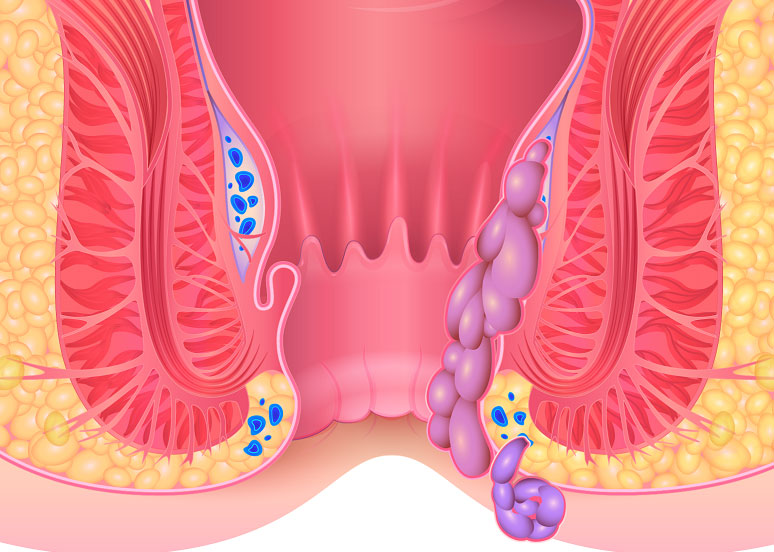
Haemorrhoids (also known as Piles) are normal anal cushions that aid in stool control. They are a vascular structure in anal canal. They become a disease when swollen or inflamed; the term “haemorrhoid” is often used to refer to the disease.These are located classically at left lateral, right anterior,
and right posterior positions (i.e. 3,7,11 o’clock position) Haemorrhoids are very common.Males and females are both affected with about equal frequency.Internal haemorrhoids are far enough inside the rectum that you can’t usually see or feel them. They don’t generally hurt because you have few pain-sensing nerves there. Bleeding may be the only sign of them. External haemorrhoids are under the skin around the anus, where there are many more pain-sensing nerves, so they tend to hurt as well as bleed.Occasionally, a clot may form in a haemorrhoid (thrombosed haemorrhoid). These are not dangerous but can be extremely painful and sometimes need to be lanced and drained.
Signs and Symptoms
The exact cause of symptomatic haemorrhoids is unknown. Multiple factors play role in development of piles. These include
- Irregular bowel habits (constipation and diarrhoea)
- Increased intra-abdominal pressure – like in pregnancy, prolonged straining
- Low fibre diet
- Ageing
- Some studies have incriminated genetics as a possible cause
- Other risk factors like – lack of exercise, obesity, smoking, prolonged sitting etc.
Symptoms of Haemorrhoids
- Internal haemorrhoids usually cause painless bright red bleeding during or after defecation. Other symptoms may include mucous discharge, a perianal mass if they prolapse through the anus.
- External haemorrhoids can become painful when thrombosed.
Grading of haemorrhoids
- Grade I – No prolapse, only dilated veins.
- Grade II – Haemorrhoids prolapse but reduce spontaneously on its own.
- Grade III – Haemorrhoids prolapse but have to be repositioned manually.
- Grade IV – Haemorrhoid are permanently prolapsed and cannot be repositioned manually.
Treatment
- Conservative – includes high fibre intake, plenty of oral intake, sitz bath/hot fomentation, laxatives and topical agents.
- Rubber Band Ligation – a rubber band is applied to haemorrhoid above the dentate line to cut off its blood.
- Grade IV – Haemorrhoid are permanently prolapsed and cannot be repositioned manually.
- Surgery – Excisional haemorrhoidectomy –is surgical excision of haemorrhoid. It is associated with significant post-operative pain.
- Stapled Haemorrhoidectomy – it is associated with relative less post-operative pain and relative faster recovery than the conventional haemorrhoidectomy.
- Laser Surgery.
- Other procedures like infra-red have been tried with variable success rates.
Innovative Technology
for Piles Treatment
Surya Multi Speciality in Nagpur - the latest surgical method for hemorrhoids (Piles).
Have a question or need to help?
If you have specific questions regarding your hemorrhoids (Piles) problem and need any help, please contact +91-9011153200